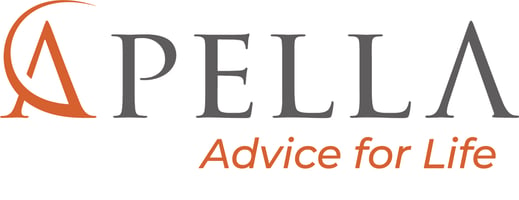Apella Wealth Blog

SECURE Act 2.0 – What do you need to know?
SECURE Act 2.0 – What do you need to know?
The SECURE Act 2.0 was signed into law on December 29th, 2022. With its signing comes an abundance of changes that can be a daunting task for individuals who wish to take on this reading. That is why we have put together a quick summary of the major changes in the SECURE Act 2.0. Although many of the changes in the act will not affect you, there are a few adjustments which could present a valuable opportunity for financial planning.
Required Minimum Distributions (RMDs) delayed (Section 107)
There are two critical years in which an individual was born to pay attention to with the further delay of RMDs. For those individuals born in the year 1951 – 1959, you will be eligible to delay taking your RMD until age 73. All individuals born in 1960 or later are qualified to delay taking their RMD until age 75. There were no changes for those individuals who were already required to take an RMD.
For the most part, the RMD delay is a good thing that can present additional tax saving options for some. Those who are not pressed to draw from their tax-deferred bucket to supplement their income now have additional time to implement strategies like Roth conversions.
While there are not any negatives for a retiree who needs to draw their RMD at a later date, beneficiaries of tax-deferred accounts should take a greater interest in participating in planning with those who will be passing along assets to them. For someone inheriting a tax-deferred account in a high-income tax bracket, seeing a large portion of the inherited money go to taxes can be devastating. If you are aware that you are the beneficiary of a tax-deferred account, consider requesting to join a meeting with the account owner and their advisor to begin establishing a relationship and uncover any tax-saving strategies. As the beneficiary, you will also want to make sure you are distributing those assets in the most tax-efficient manner as the new 10-year rule for inherited accounts could leave you paying needlessly high taxes if you don’t plan properly.
Changes to Roth (Section 601, 604, & 603)
The Secure Act 2.0 brought about multiple changes involving Roth accounts. Keep in mind that while many of these changes take effect in 2023, that does not necessarily mean these options will be available right away.
For starters, SIMPLE Roth IRAs and SEP Roth IRAs are now available for those who previously qualified for having a SIMPLE IRA and SEP IRA. Be prepared for it to take some time for custodians to be able to open and support these new Roth account types. Additionally, employer matching contributions will now have the option to be treated as Roth contributions for employers who adopt this option. Although more tax-free growth sounds like a no-brainer, keep in mind that this employer match will be counted towards your ordinary income. Much like a Roth conversion, individuals will want to be prepared with sufficient cash to pay for the additional ordinary income tax so that they aren’t blindsided come tax time. Finally, individuals who have wages from their plan sponsor that exceeds $145,000 will be required to make any catch-up contributions as Roth contributions. The wording is very specific with this section as the wages must come from the employer sponsoring the plan. If your earned income is in excess of $145,000, but you work for two different employers and have less than $145,000 in wages for one, then you can still make traditional pre-tax contributions for your catch-up contributions.
Changes to Catch up Contributions (Section 109)
Beginning in 2025, individuals who are between the ages of 60 to 63 will be permitted to contribute more than the standard catch up contribution that begins at age 50. The amount of additional catch-up contributions is the greater of $10,000 or 150% of the standard catch up contribution for that year. Please note from the previous section that individuals with wages in excess of $145,000 from their employer who sponsors their plan will be required to contribute these additional catch-up contributions as Roth.
529 to Roth IRA Transfers (Section 126)
Effective in 2024, some individuals may be able to take advantage of making transfers from a 529 plan to a Roth IRA that is owned by the beneficiary of the 529 plan. Qualifying for these transfers may prove difficult for many due to the following requirements that must be satisfied.
- The named beneficiary of the 529 must be the same individual as the owner of the Roth account
- The 529 must have been opened for more than 15 years
- Contributions and earnings made to the 529 in the last 5 years are not permitted to be rolled over to the Roth IRA
- The 529 to Roth IRA rollover is limited to the annual IRA contribution limit for the owner of the Roth IRA account and the owner of the Roth IRA must have earned income that covers the amount of the rollover
- The lifetime limit of these 529 to Roth IRA rollovers is $35,000
It will be difficult for many individuals to meet all of these conditions, but for those that do, this does help address some of the concerns for what to do with leftover 529 balances that are not needed for qualified education expenses.
As your advisor, we are here to do the heavy lifting of comprehending the rules and regulations of this act and any others that are released. We have dived into the reading, attended multiple webinars breaking down planning opportunities, and collaborated with other financial professionals to ensure we have a thorough understanding of the SECURE ACT 2.0. If there is any further information you are interested in regarding the Secure Act 2.0 that is not presented in this article, please reach out to your advisor and we will be happy to assist you.
Apella Capital, LLC, DBA Apella Wealth provides this communication on this site as a matter of general information. Information contained herein, including data or statistics quoted, are from sources believed to be reliable but cannot be guaranteed or warranted. Nothing on this site represents a recommendation of any particular security, strategy, or investment product. The opinions of the author are subject to change without notice. Due to various factors, including changing market conditions and/or applicable laws, the content may not be reflective of current opinions or positions. All content on this site is for educational purposes and should not be considered investment advice or an offer of any security for sale. Please be advised that Apella Capital does not provide tax or legal advice and nothing either stated or implied here on this site should be inferred as providing such advice. Apella does not approve or endorse any third party communications on this site and will not be liable for any such posts.
Diversification seeks to reduce volatility by spreading your investment dollars into various asset classes to add balance to your portfolio. Using this methodology, however, does not guarantee a profit or protection from loss in a declining market.
Related Articles
Four Ways to Jumpstart Your Financial Plan for Success
✔ Consolidate investment accounts with a single trusted Financial Planner.Some investors believe in...
